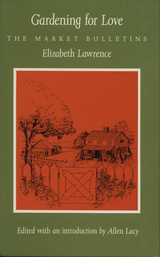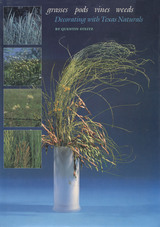

It was Eudora Welty who awakened Elizabeth Lawrence's interest in this fascinating topic by putting her name on the mailing list of The Mississippi Market Bulletin, a twice-monthly collection of classified advertisements founded in 1928 and still published today. Lawrence soon discovered market bulletins from the Carolinas and other Southern states, as well as similar bulletins published privately in the North. She began ordering plants from the bulletins, and there ensued a lively exchange of letters wit the women who sold them.
Gardening for Love is Lawrence's exploration of this little-known side of American horticulture and her affectionate tribute to country people who shared her passion for plants. Drawing on the letters she received, sometimes a great many of them from the same persons over many years, she delves into traditional plant lore, herbal remedies, odd and often highly poetic vernacular plant names peculiar to particular regions of the South, and the herb collectors of the mountains of the Carolinas and Georgia. She focuses primarily on the Southeast and the Deep South, but her wide knowledge of both literature and botany gives Gardening for Love a dimension that transcends the category of regional writing.

Purple three-awn.
Tree of heaven.
Alamo vine.
Narrowleaf cattail.
These exotic and fanciful names conjure up visions of lush foliage, colorful grasses, and dense plant life. They are, in fact, names of native and naturalized Texas plants—grasses, pods, vines, and weeds. Lovely and all-too-often overlooked in nature, they become ornamental delights when used imaginatively and decoratively.
Grasses, Pods, Vines, Weeds introduces 44 of Texas' most common and important naturals. Quentin Steitz shows how to recognize them and discover their aesthetic wealth. By taking the reader through all of the steps involved in utilizing naturals—from harvest to design—her book becomes an important tool for floral and landscape designers, decorators, horticulturalists, home gardeners, botanists: all those people who enjoy hands-on experience with Texas' vast array of native and naturalized plants.
The book presents clear and concise descriptions of many Texas naturals, accompanied by approximately 150 full-color photographs showing each in one or more stages of growth and also in a design. The reader can see the plant as it looks not only in the wild but also in an arrangement. The author offers techniques on how the species can be prepared for display, discussing drying and arranging. And a chapter on cultivation and conservation suggests to outdoor enthusiasts species they can grow for decorative natural materials as well as conserve and appreciate in the wild.
Grasses, Pods, Vines,Weeds is enhanced by flora selected, collected, prepared, and dried by the author. These hand-culled materials have been used in designs contributed by some nineteen notable floral designers as well as the author. The text and designs combine to reveal the fresh, creative applications of Texas' decorative naturals and to increase our pleasure in the wonders of natural Texas.

Inspiration, happy accidents, and outright obsessions have all had their way with gardens—but nothing has done more to shape the modern garden than plants themselves. In a story that ranges from continent to continent and spans four centuries, botanist and gardener David Stuart reveals how the garden as we know it was created not by garden designers but by ordinary gardeners responding to exotic and novel plants that suggested new spaces, places, and means of display. The history begins with two earth-changing events—the establishment of colonies in the Americas and the spread of the Turkish empire. Both brought the first astonishing wave of flowering exotics to gardens across Europe. Stuart relates how, over the following centuries, the influx of new plants inspired a frenzy of hybridization (at first by a new breed of gardener, the “florist,” later by nurserymen), which in turn led to such features as the familiar herbaceous border, flower bed, and rose garden, as well as the now little-known rockery, shrubbery, and “wilderness.”
From the Dutch tulip mania, the eighteenth-century European passion for “American gardens,” and on to the rhododendron craze of the nineteenth century, Stuart’s book traces the shape of the modern garden as it changed with the fashion, returning at last to classic, cottage garden varieties long neglected in favor of the foreign and new. In conclusion, Stuart looks at plant prospecting today—now that the collecting of plants may prove essential to protecting botanical diversity and preserving plant species rapidly disappearing from the wild.
READERS
Browse our collection.
PUBLISHERS
See BiblioVault's publisher services.
STUDENT SERVICES
Files for college accessibility offices.
UChicago Accessibility Resources
home | accessibility | search | about | contact us
BiblioVault ® 2001 - 2024
The University of Chicago Press









